Dielectric Barrier Discharge (DBD) Plasma Assisted Synthesis of Ag2O Nanomaterials and Ag2O/RuO2 Nanocomposites
Abstract
:1. Introduction
2. Results and Discussion
2.1. X-Ray Diffraction Study for Structural Analysis
2.2. Surface Morphology and Elemental Analysis
2.3. Particle Size Analysis
2.4. Effect of NaOH Concentration on the Morphology and Growth Mechanism
2.5. Bulk and Surface Chemical Analysis
2.6. Thermal Study
3. Experimental Section
3.1. DBD Plasma Reactor Setup
3.2. Material Synthesis
3.3. Material Characterization
4. Conclusions
Supplementary Materials
Acknowledgments
Author Contributions
Conflicts of Interest
References
- Wang, X.; Li, S.; Yu, H.; Yu, J.; Liu, S. Ag2O as a new visible-light photocatalysts: Self-stability and high photocatalytic activity. Chem. Eur. J. 2011, 17, 7777–7780. [Google Scholar] [CrossRef] [PubMed]
- Wang, W.; Zhao, Q.; Dong, J.; Li, J. A novel silver oxides oxygen evolving catalyst for water splitting. Int. J. Hydrogen Energy 2011, 36, 7374–7380. [Google Scholar] [CrossRef]
- Rahman, M.A.; Khan, S.B.; Jamal, A.; Faisal, M.; Asiri, A.M. Fabrication of highly sensitive acetone sensor based on sonochemically prepared as-grown Ag2O nanostructures. Chem. Eng. J. 2012, 192, 122–128. [Google Scholar] [CrossRef]
- Jin, Y.; Dai, Z.; Liu, F.; Kim, H.; Tong, M.; Hou, Y. Bactericidal mechanisms of Ag2O/TNBs under both dark and light conditions. Water Res. 2013, 47, 1837–1847. [Google Scholar] [CrossRef] [PubMed]
- Fu, H.-T.; Zhao, L.-M.; Luo, M.; Zhang, H.-Y.; Zhang, J. Determination of Chloracetic Acids in Drinking Water by Ion Chromatography Using Silver Oxide as Precipitant Eliminating Interference of Chlorate in Matrix. Chin. J. Anal. Chem. 2008, 36, 1407–1410. [Google Scholar] [CrossRef]
- Lee, Y.; Ye, B.-U.; Yu, H.K.; Lee, J.-L.; Kim, M.H.; Baik, J.M. Facile Synthesis of Single Crystalline Metallic RuO2 Nanowires and Electromigration-Induced Transport Properties. J. Phys. Chem. C 2003, 115, 4611–4615. [Google Scholar] [CrossRef]
- Lee, K.-Y.; Chen, C.-A.; Lian, H.-B.; Chen, Y.-M.; Huang, Y.-S.; Keisser, G. Pattern, growth and field emission characteristics of flower-like RuO2 nanostructures. Jpn. J. Appl. Phys. 2010, 49, 105002–105005. [Google Scholar] [CrossRef]
- Ananth, A.; Mok, Y.S. Synthesis of RuO2 nanomaterials under dielectric barrier discharge plasma at atmospheric pressure-influence of substrates on the morphology and application. Chem. Eng. J. 2014, 239, 290–298. [Google Scholar] [CrossRef]
- Ananth, A.; Dharaneedharan, S.; Gandhi, M.S.; Heo, M.-S.; Mok, Y.S. Novel RuO2 nanosheets–facile synthesis, characterization and application. Chem. Eng. J. 2013, 223, 729–736. [Google Scholar] [CrossRef]
- Ananth, A.; Arthanareeswaran, G.; Ismail, A.F.; Mok, Y.S.; Matsura, T. Effect of bio-mediated route synthesized silver nanoparticles for modification of polyethersulfone membranes. Colloids Surf. A 2014, 451, 151–160. [Google Scholar] [CrossRef]
- Hosseinpour-Mashkani, S.M.; Ramezani, M. Silver and Silver-Oxide Nanoparticles: Synthesis and Characterization by Thermal Evaporation. Mater. Lett. 2014, 130, 259–262. [Google Scholar] [CrossRef]
- Wei, Y.; Zuo, X.; Li, X.; Song, S.; Chen, L.; Shen, J.; Meng, Y.; Zhao, Y.; Fang, S. Dry Plasma Synthesis of Graphene Oxide–Ag Nanocomposites: A Simple and Green Approach. Mater. Res. Bull. 2014, 53, 145–150. [Google Scholar] [CrossRef]
- Li, Y.; Zhang, Y.; Fu, H.; Wang, Z.; Li, X. Plasma-assisted speedy synthesis of mesoporous Ag2O nanotube. Mater. Lett. 2014, 126, 131–134. [Google Scholar] [CrossRef]
- Kim, D.W.; Park, D.-H. Preparation of indium tin oxide (ITO) nanoparticles by DC arc plasma. Surf. Coat. Technol. 2010, 205, S201–S205. [Google Scholar] [CrossRef]
- Ananth, A.; Gandhi, M.S.; Mok, Y.S. Dielectric barrier discharge (DBD) plasma reactor: An efficient tool to prepare novel RuO2 nanorods. J. Phys. D 2013, 46, 155202–155209. [Google Scholar] [CrossRef]
- Marino, E.; Huijser, T.; Creyghton, Y.; Hejiden, A.V.D. Syntheis and coating of copper oxide nanoparticles using atmospheric pressureplasmas. Surf. Coat. Technol. 2007, 201, 9205–9208. [Google Scholar] [CrossRef]
- Pootawang, P.; Saito, N.; Takai, O.; Lee, S.Y. Rapid synthesis of ordered hexagonal mesoporous silica and their incorporation with Ag nanoparticles by solution plasma. Mater. Res. Bull. 2012, 47, 2726–2729. [Google Scholar] [CrossRef]
- Ananth, A.; Mok, Y.S. Dielectric barrier discharge plasma-mediated synthesis of several oxide nanomaterials and its characterization. Powder Technol. 2015, 269, 259–266. [Google Scholar] [CrossRef]
- Choi, S.; Lee, M.-S.; Park, D.-W. Photocatalytic performance of TiO2/V2O5 nanocomposite powder prepared by DC arc plasma. Curr. Appl. Phys. 2014, 14, 433–438. [Google Scholar] [CrossRef]
- Sullivan, K.T.; Wu, C.; Piekiel, N.W.; Gaskell, K.; Zachariah, M.R. Synthesis and reactivity of nano-Ag2O as an oxidizer for energetic systems yielding antimicrobial products. Combust. Flame 2013, 160, 438–446. [Google Scholar] [CrossRef]
- Gultekin, D.; Alaf, M.; Akbulut, H. Synthesis and characterization of ZnO nanopowders and ZnO-CNT nanocomposites prepared by chemical precipitation route. Acta Phys. Polonica A 2013, 123, 274–276. [Google Scholar] [CrossRef]
- Inoue, M; Hirasawa, I. The relationship between crystal morphology and XRD peak intensity on CaSO4·2H2O. J. Cryst. Growth 2013, 380, 169–175. [Google Scholar]
- Banerjee, S.; Maity, A.K.; Chakravorty, D. Quantum confinement effect in heat treated silver oxide nanoparticles. J. Appl. Phys. 2000, 87, 8541–8544. [Google Scholar] [CrossRef]
- Yong, N.L.; Ahmad, A.; Mohammad, A.W. Synthesis and characterization of silver oxide nanoparticles by a novel method. Int. J. Sci. Eng. Res. 2013, 4, 155–158. [Google Scholar]
- Xie, Y.; Sherwood, P.M.A. Ultrahigh purity graphite electrode by core level and valence band XPS. Surf. Sci. Spectra 1992, 1, 367–372. [Google Scholar] [CrossRef]
- Borman, V.D.; Gusev, E.P.; Lebedinski, Y.Y.; Troyan, V.I. Mechanism of submonolayer oxide formation on silicon surfaces upon thermal oxidation. Phys. Rev. B 1994, 49, 5415–5423. [Google Scholar] [CrossRef]
- Rodriguez, J.A. Metal-Metal Bonding on Surfaces: Electronic and Chemical Properties of Ag on Ru(001). Surf. Sci. 1993, 296, 149–163. [Google Scholar] [CrossRef]
- Tjeng, L.H.; Meinders, M.B.J.; van Elp, J.; Ghijsen, J.; Sawatzky, G.A.; Johnson, R.L. Electronic structure of Ag2O. Phys. Rev. B 1990, 41, 3190–3199. [Google Scholar] [CrossRef]
- Kaushik, V.K. XPS Core Level Spectra and Auger Parameters for Some Silver Compounds. J. Electron Spectrosc. Relat. Phenom. 1991, 56, 273–277. [Google Scholar] [CrossRef]
- Gerenser, L.J. Photoemission investigation of silver/poly(ethylene terephthalate) interfacial chemistry: The effect of oxygen-plasma treatment. J. Vac. Sci. Technol. A 1990, 8, 3682–3691. [Google Scholar] [CrossRef]
- Pashutski, A.; Hoffman, A.; Folkman, M. Low temperature XPS and AES studies of O2 adsorption on Al(100). Surf. Sci. 1989, 208, L91–L97. [Google Scholar] [CrossRef]
- Sarma, D.D.; Rao, C.N.R. XPES studies of oxides of second- and third-row transition metals including rare earths. J. Electron Spectrosc. Relat. Phenom. 1980, 20, 25–45. [Google Scholar] [CrossRef]
- Shen, J.Y.; Adnot, A.; Kaliaguine, S. An ESCA study of the interaction of oxygen with the surface of ruthenium. Appl. Surf. Sci. 1991, 51, 47–60. [Google Scholar] [CrossRef]
- Jelic, D.; Penavin-Skundric, J.; Majstorovic, D.; Mentus, S. The thermogravimetric study of silver(I) oxide reduction by hydrogen. Thermochim. Acta 2011, 526, 252–256. [Google Scholar] [CrossRef]
- Waterhouse, G.I.N.; Bowmaker, G.A.; Metson, J.B. The thermal decomposition of silver (I, III) oxide: A combined XRD, FT-IR and Raman spectroscopic study. Phys. Chem. Chem. Phys. 2001, 3, 3838–3845. [Google Scholar] [CrossRef]
- Siddiqui, M.R.H.; Adil, S.F.; Assal, M.E.; Ali, R.; Al-Warthan, A. Synthesis and characterization of silver oxide and silver chloride nanoparticles with high thermal stability. Asian J. Chem. 2013, 25, 3405–3409. [Google Scholar]
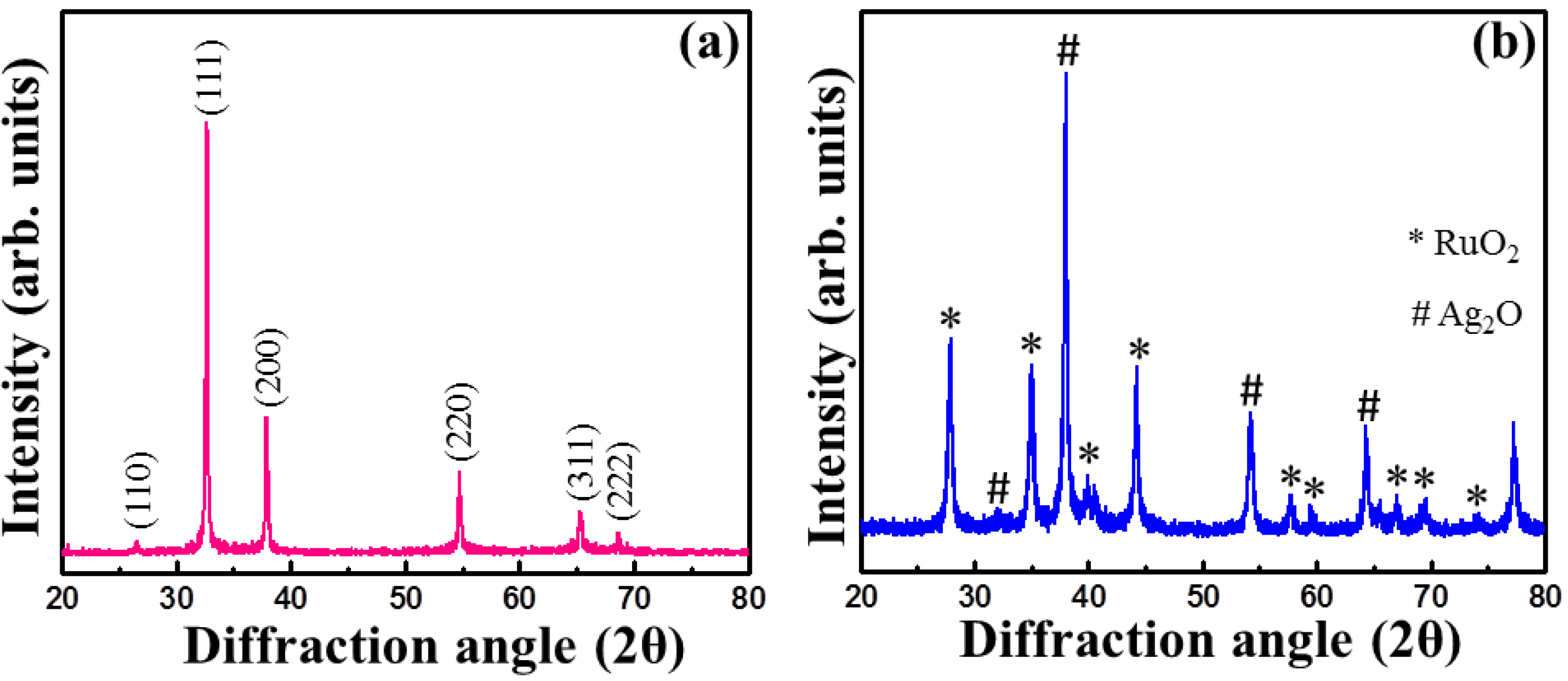
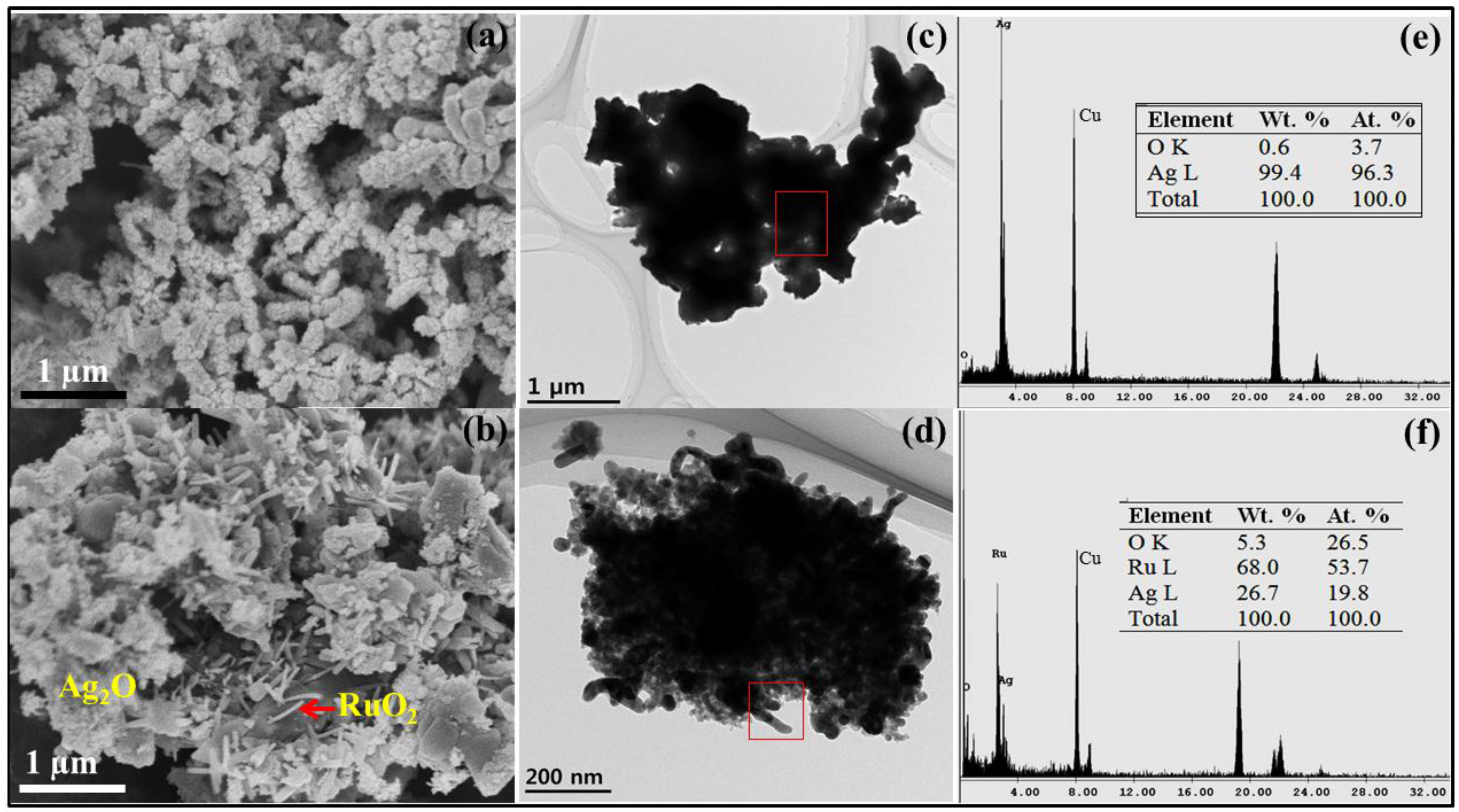
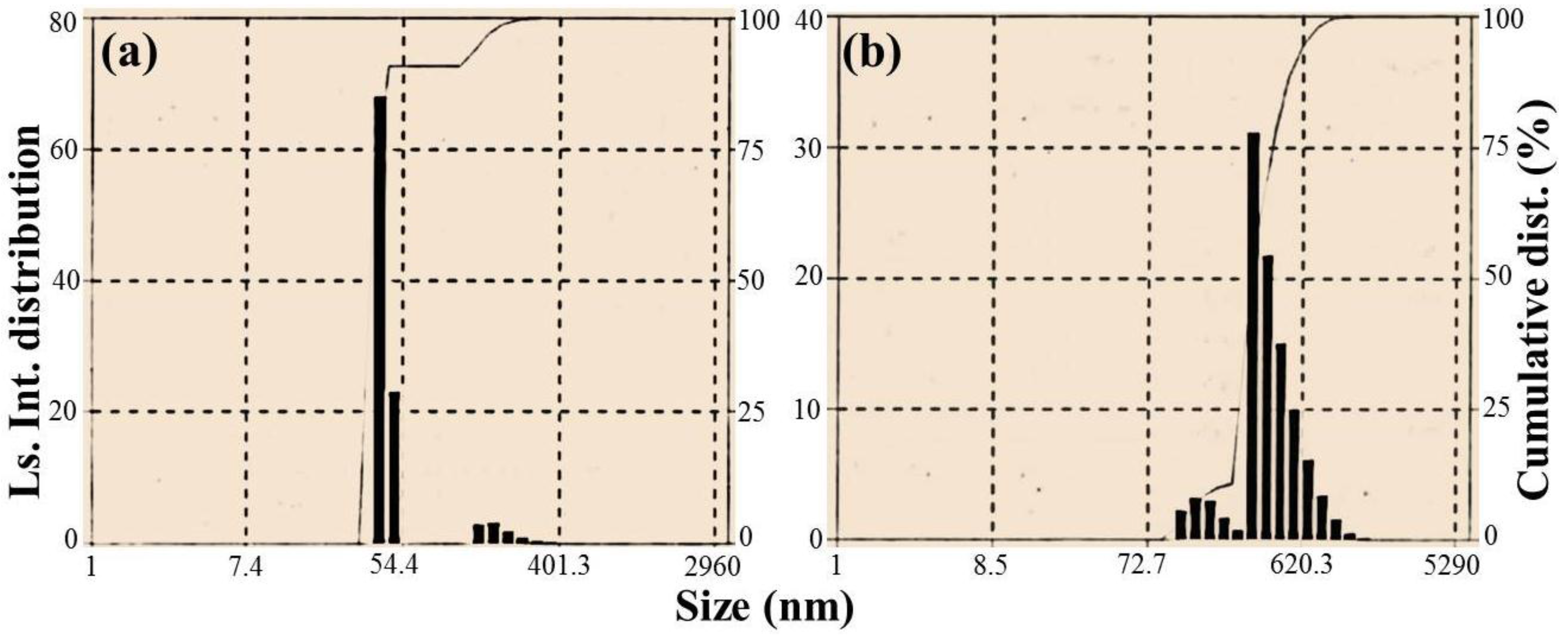
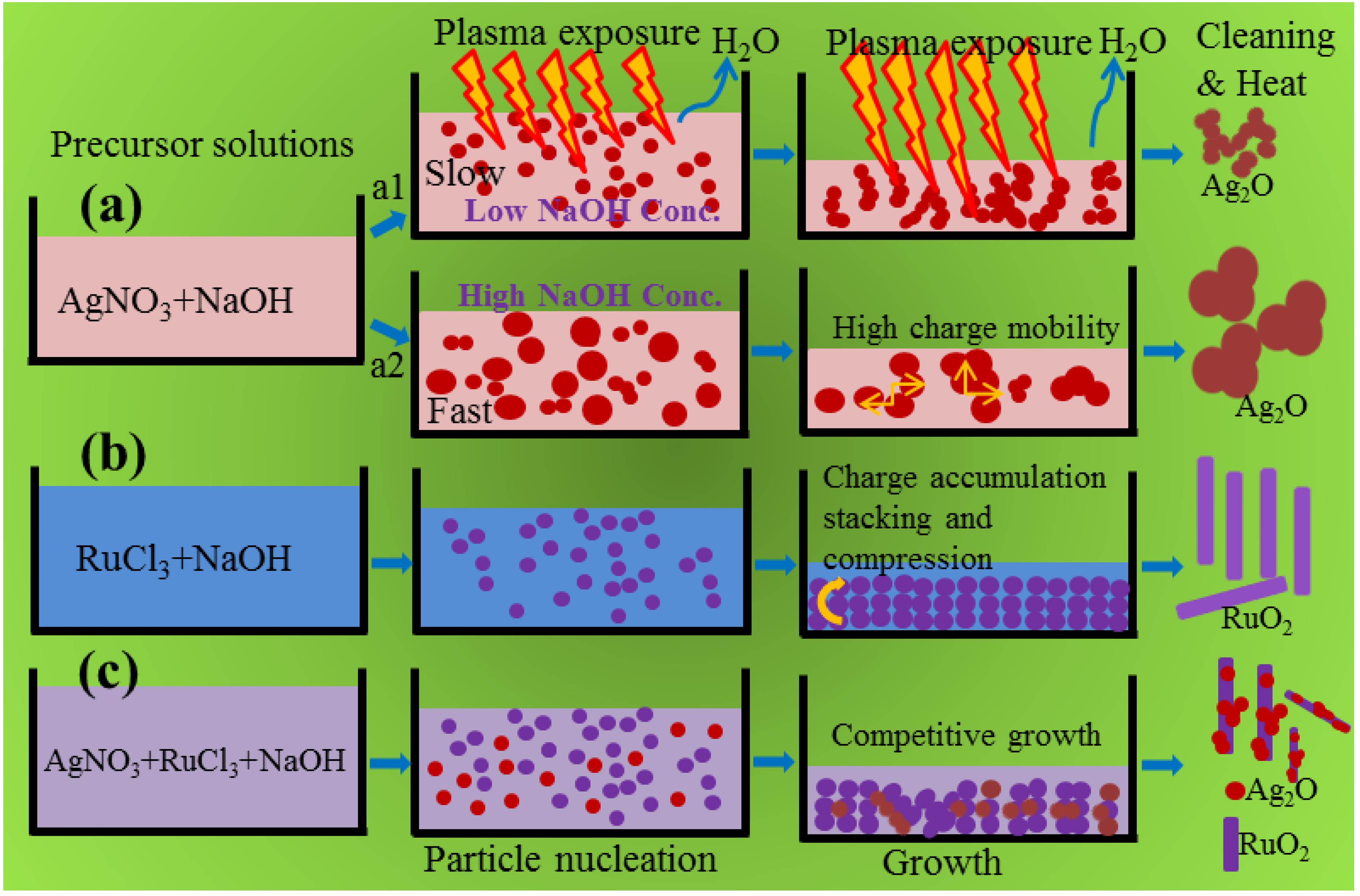
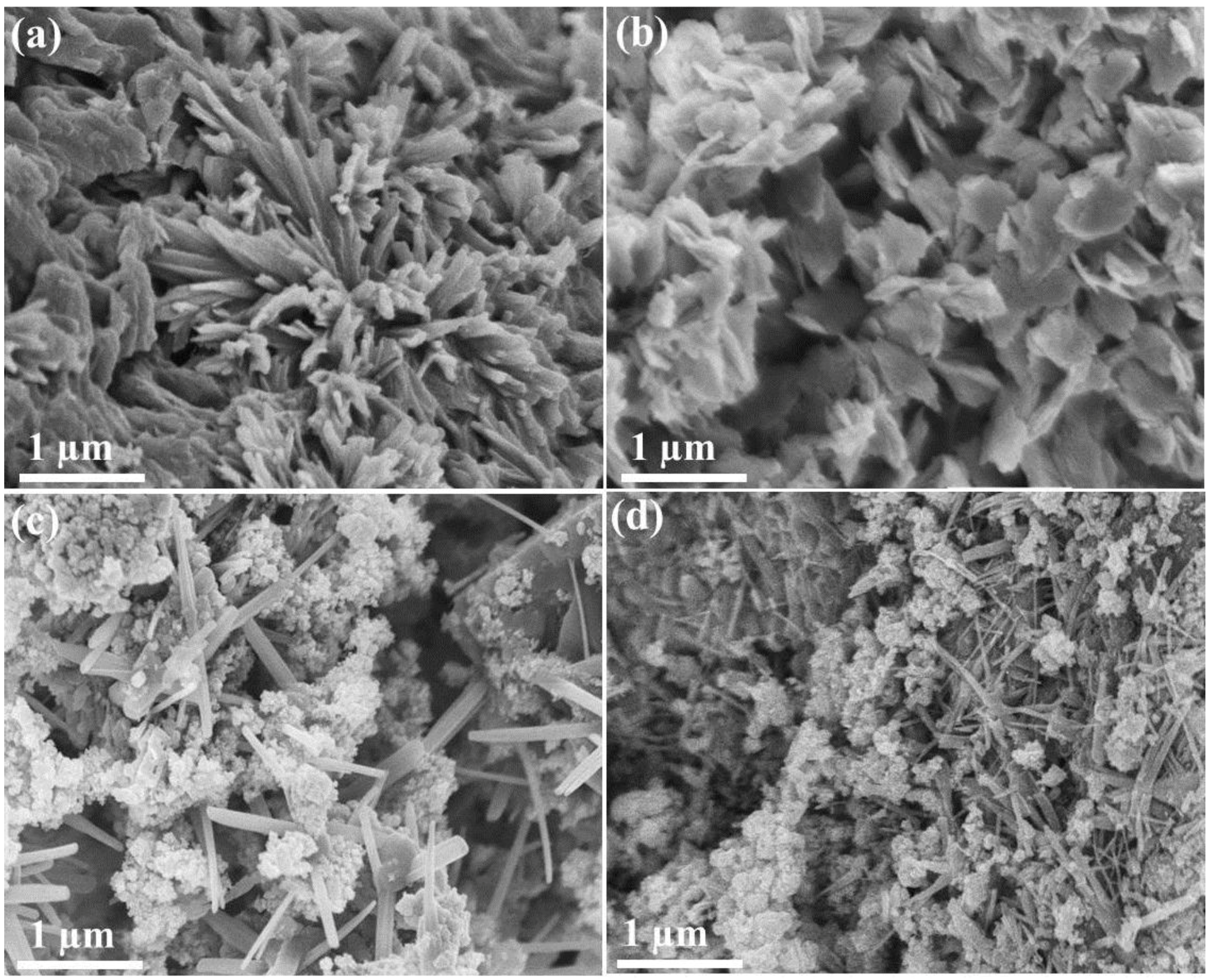
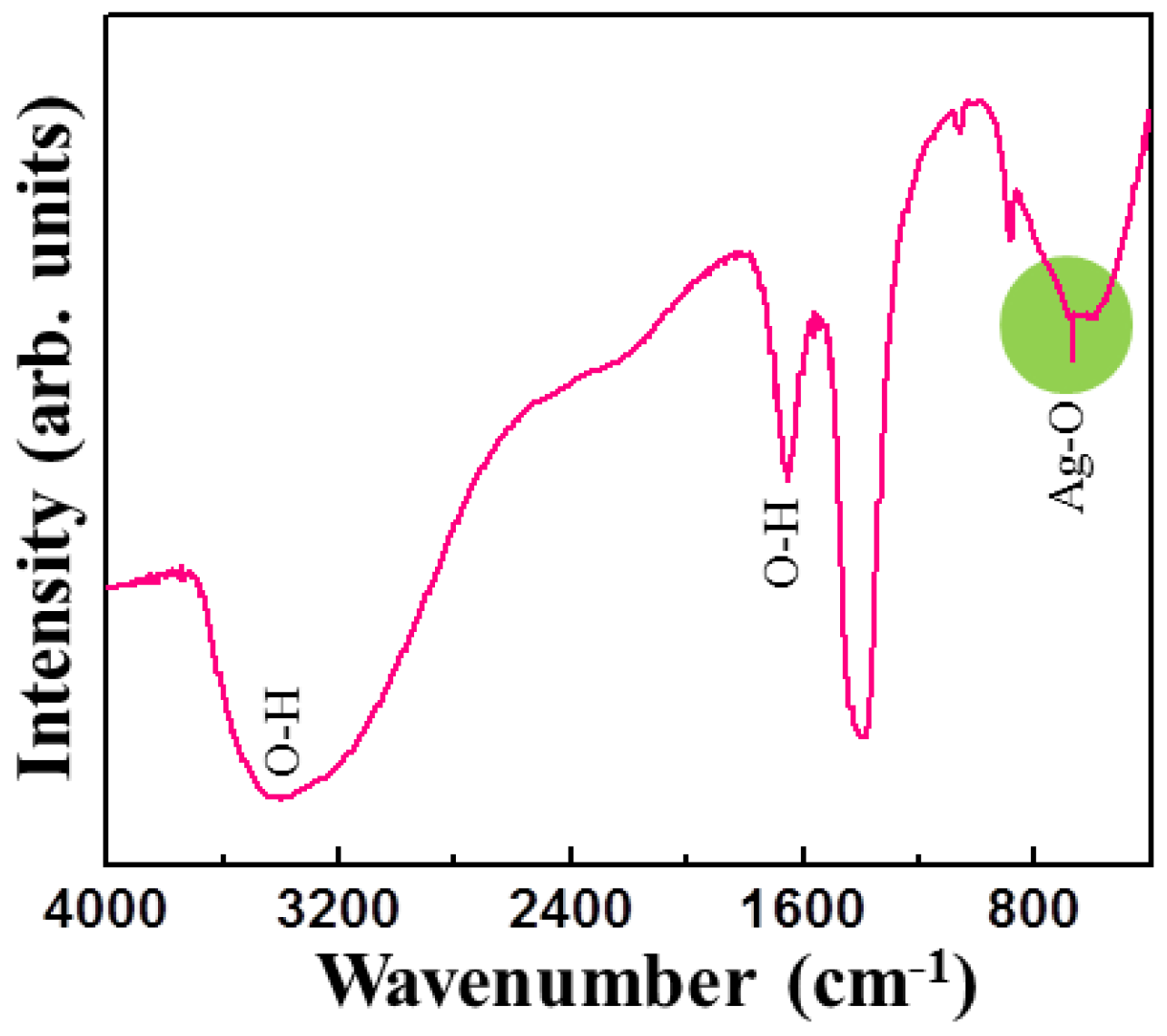
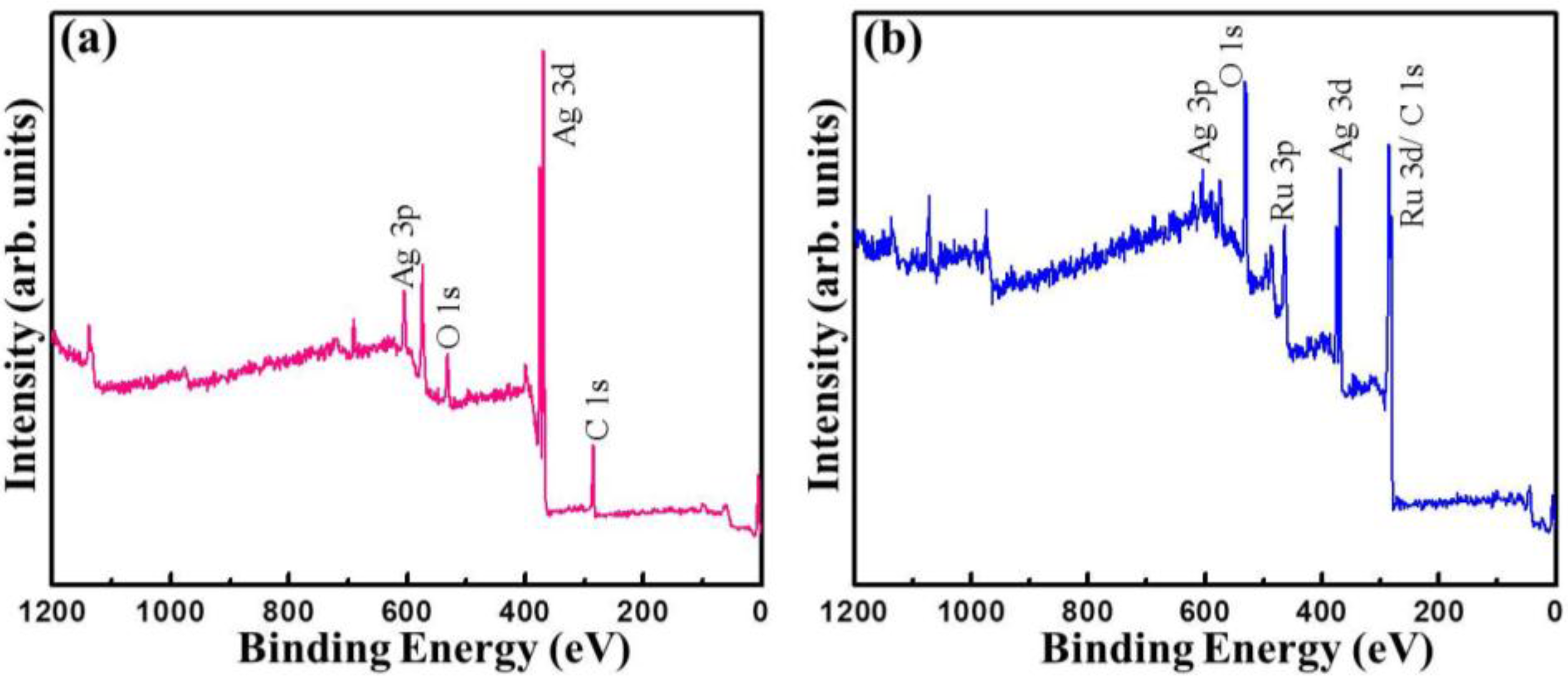
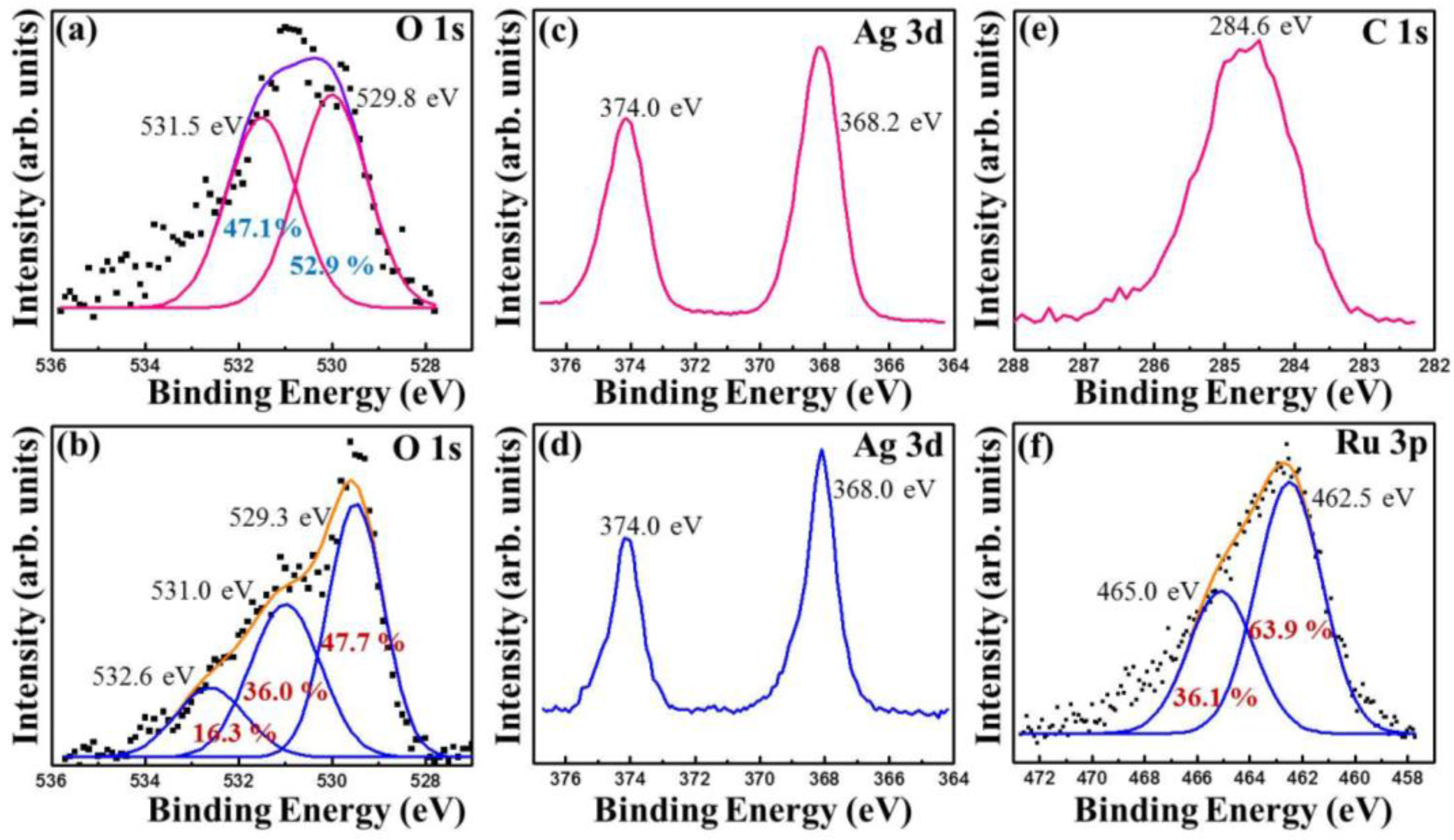
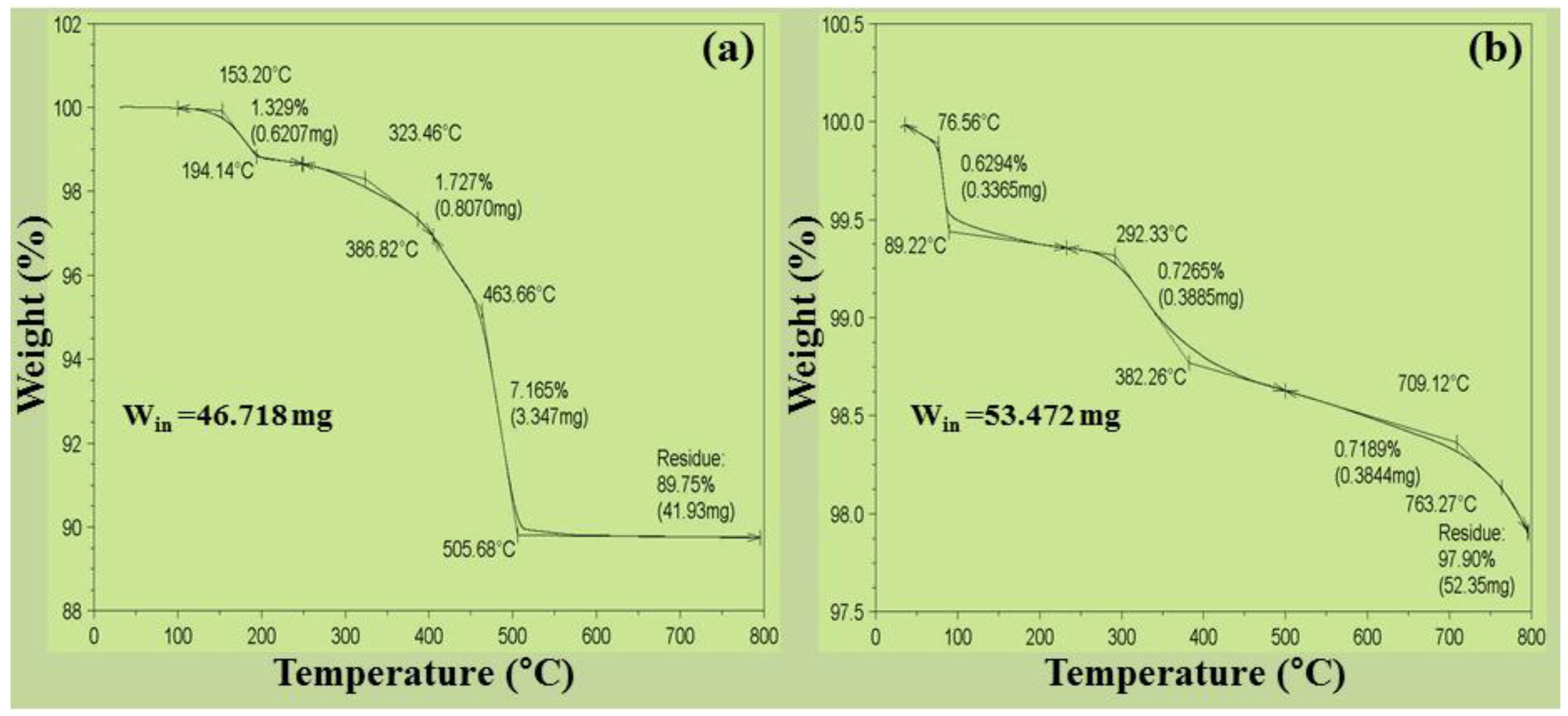
| Binding Energy (eV) | Species Assignment | Reference |
|---|---|---|
| 284.6 | Carbon | [25] |
| 368.2, 374.0, 529.3, 529.8 | Ag2O | [27,28,29,30,31] |
| 462.5 | RuO2 | [32] |
| 531.5 | Oxygen from adsorbed water | [31] |
| 531.0, 465.0 | RuOx/Ru | [33] |
| 532.6 | Diffused oxygen atoms | [26] |
| Sample | Initial Sample Mass (mg) | Initial O2 Mass (mg) | Final Sample Mass (mg) | Lost O2 Mass (mg) | Remaining O2 Mass (mg) | Remaining O2 Mass (%) |
|---|---|---|---|---|---|---|
| Ag2O | 46.718 | 3.22 | 41.93 | 2.89 | 0.330 | 0.700 |
| Ag2O/RuO2 | 53.472 | 7.031 | 52.35 | 6.883 | 0.148 | 0.276 |
| * RuO2 | 42.988 | 10.388 | 40.84 | 9.822 | 0.566 | 1.192 |
© 2016 by the authors; licensee MDPI, Basel, Switzerland. This article is an open access article distributed under the terms and conditions of the Creative Commons by Attribution (CC-BY) license (http://creativecommons.org/licenses/by/4.0/).
Share and Cite
Ananth, A.; Mok, Y.S. Dielectric Barrier Discharge (DBD) Plasma Assisted Synthesis of Ag2O Nanomaterials and Ag2O/RuO2 Nanocomposites. Nanomaterials 2016, 6, 42. https://doi.org/10.3390/nano6030042
Ananth A, Mok YS. Dielectric Barrier Discharge (DBD) Plasma Assisted Synthesis of Ag2O Nanomaterials and Ag2O/RuO2 Nanocomposites. Nanomaterials. 2016; 6(3):42. https://doi.org/10.3390/nano6030042
Chicago/Turabian StyleAnanth, Antony, and Young Sun Mok. 2016. "Dielectric Barrier Discharge (DBD) Plasma Assisted Synthesis of Ag2O Nanomaterials and Ag2O/RuO2 Nanocomposites" Nanomaterials 6, no. 3: 42. https://doi.org/10.3390/nano6030042







